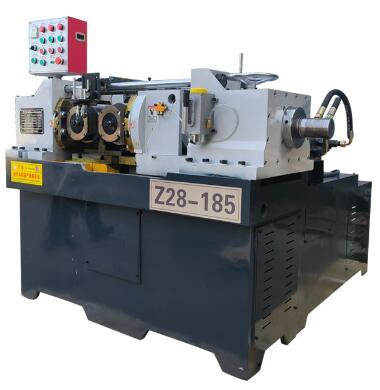Types of Thread Rolling Machines
Thread rolling machines come in various forms, designed to accommodate different production needs. The primary types of thread rolling machines are flat die thread rolling machines, rotary die thread rolling machines, and planetary die thread rolling machines. Each of these types has unique characteristics that make them suitable for specific applications:
Flat Die Thread Rolling Machines: This is the most common type of thread rolling machine. It uses two flat dies with thread profiles that match the desired shape. The workpiece is placed between the dies, which rotate and apply pressure to create the thread. These machines are ideal for producing external threads and are commonly used for screws, bolts, and fasteners. The flat die method is cost-effective for medium to large-scale production runs and is highly efficient for producing standard thread forms.
Rotary Die Thread Rolling Machines: Rotary die thread rolling machines use a set of rotary dies that move in sync with the workpiece. This type of machine can be used to create both external and internal threads, making it more versatile. Rotary die machines are ideal for smaller parts where space constraints are important, as they offer a compact design and can handle high-speed operations. These machines are commonly used in applications where high-volume production is needed, such as in automotive or aerospace industries.
Planetary Die Thread Rolling Machines: Planetary die machines use a set of dies that rotate around the workpiece, creating the thread by applying force to the material from multiple directions. These machines are typically used for large production volumes and complex threading requirements. The planetary rolling process can produce threads with high accuracy, reducing the chance of defects. They are suitable for high-precision components such as fasteners and bolts used in critical applications.
The Thread Rolling Process
The thread rolling process is a cold-forming operation where the material (usually metal) is deformed under pressure to create threads. It is a fast and efficient process that requires careful control of several factors, such as pressure, speed, and die configuration. Here’s a general overview of the process:
Preparation of the Workpiece: The workpiece is first prepared by cutting it to the required length and ensuring it is free from any surface imperfections. The surface condition of the material is crucial as it affects the final quality of the thread. Clean and smooth materials lead to higher thread quality and fewer defects.
Die Setup: The appropriate die set is chosen based on the type of thread required. The die is mounted onto the machine, and the workpiece is placed between the dies. The dies are then rotated, applying a significant amount of pressure to the workpiece to form the thread.
Rolling Process: As the dies rotate, they move along the workpiece, gradually shaping the material into the desired thread form. The workpiece is continuously rotated, allowing for the creation of uniform, high-quality threads along its length. The cold-forming process ensures that the material retains its strength, making the threads more durable and resistant to wear and tear.
Post-Rolling: After the thread is rolled, the part may go through secondary processes such as heat treatment, coating, or finishing to improve its properties and functionality.
Advantages of Thread Rolling
Thread rolling offers several advantages over traditional cutting methods like tapping or machining. These benefits make thread rolling a preferred choice in industries requiring high-quality, durable threads. Some of the main advantages of thread rolling include:
Superior Thread Strength: Thread rolling produces threads by deforming the material rather than cutting it, which means the grain structure of the material is not disrupted. This results in threads that are stronger and more resistant to fatigue, making them ideal for high-stress applications.
High Production Speed: Thread rolling is a high-speed process, allowing manufacturers to produce large volumes of threaded parts quickly. The cold-forming process also reduces the need for secondary machining or finishing, which further increases efficiency.
Enhanced Precision: Thread rolling machines are capable of producing threads with high accuracy, which is essential in industries where precise dimensions and tolerances are critical. The process allows for the production of threads with minimal deviation, ensuring consistent quality across large production runs.
Cost-Effectiveness: Although thread rolling machines require a higher initial investment compared to traditional cutting machines, they can result in significant cost savings over time. The process is faster, and it produces fewer scrap parts, leading to lower overall production costs.
Material Savings: Since thread rolling does not remove material but rather deforms it, there is no material waste generated, making it a more sustainable and cost-efficient option compared to methods like cutting or machining. This results in a lower material cost per part.
No Need for Lubricants: The thread rolling process does not require the use of lubricants, reducing the need for cleaning and maintenance. This makes the process cleaner and more environmentally friendly.
Applications of Thread Rolling
Thread rolling is used in a wide range of industries, from automotive and aerospace to electronics and construction. Common applications include:
Fasteners: Bolts, screws, and nuts used in machinery and structural applications.
Automotive: Parts such as shafts, studs, and components that require strong, reliable threads.
Aerospace: Critical components such as fasteners and bolts used in aircraft and spacecraft, where thread strength and precision are essential.
Electronics: Small, high-precision threaded components for devices and assemblies.
Construction: Steel rods, bolts, and other construction fasteners.



Comments Please sign in or sign up to post.
0
0 of 500 characters used